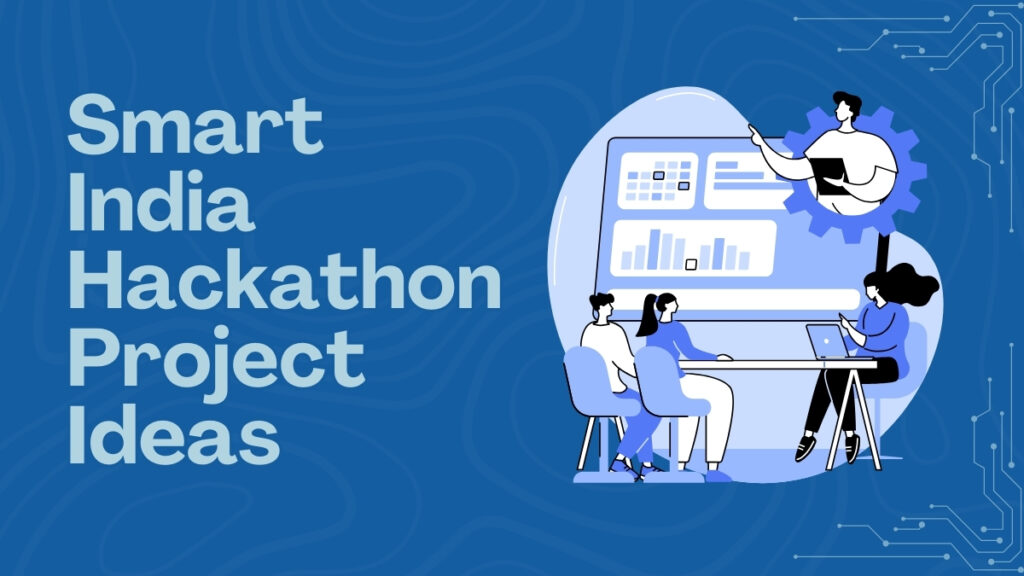Discover innovative Smart India Hackathon project ideas. Get inspired with practical tips and themes to turn your creative concepts into impactful solutions. Start making a difference today!
Want to make a difference? The Smart India Hackathon is your chance to turn ideas into reality. Bright minds come together to solve big challenges.
Not sure where to start? We’re here to help. This blog will guide you on finding inspiration and creating something amazing.
We’ll cover the latest themes, share easy tips, and help you build a winning project. Whether you’re new or experienced, let’s dive in and make a real impact!
Smart India Hackathon Project Ideas PDF
The potential impact of hackathon projects on society
Hackathons do more than just code; they drive change. Here’s how Smart India Hackathon projects make a difference:
- Boost economic growth: New ideas create jobs and businesses.
- Enhance quality of life: Improve healthcare, education, and agriculture.
- Advance digital India: Speed up tech transformation.
- Empower youth: Inspire the next generation of innovators.
- Foster innovation: Encourage problem-solving and experimentation.
These projects can create lasting, positive change.
Identifying Potential Problem Areas
To create a great hackathon project, start by finding a real-world problem. Here’s how:
Find Problems in Your Community
- Observe: Look for issues around you.
- Talk: Ask people about their challenges.
- Empathize: Understand problems from others’ perspectives.
Methods for Finding Problems
- Surveys: Collect data on challenges.
- Interviews: Talk to people for deeper insights.
- Observation: Watch how people interact with their environment.
- Social Media: Check for common issues online.
Use these tips to find real issues and create impactful projects.
Smart India Hackathon Project Ideas
Check out Smart India hackathon project ideas:-
Healthcare
- Telemedicine Platform: Remote consultations with video and AI diagnosis.
- Health Wearables: Devices to track and alert on vital signs.
- Mental Health Chatbot: AI support for mental health.
- Medication Reminder App: Tracks and reminds about medications.
- Diagnostic Tool: AI for analyzing medical images.
- Virtual Health Assistant: Voice-controlled health queries.
- Emergency Alert System: Sends alerts with real-time location.
- Chronic Disease Management: Personalized management tools.
- ECG Monitor: Continuous heart activity monitoring.
- Healthcare Data Analytics: Analyzes patient data for better care.
Agriculture
- Smart Irrigation: IoT system for optimized irrigation.
- Crop Disease Detection: Image recognition for plant diseases.
- Precision Farming: Drones and sensors for targeted farming.
- Automated Fertilizer Dispenser: Dispenses fertilizers based on soil needs.
- Weather Forecast App: Accurate forecasts for farmers.
- Pest Monitoring: Sensors for tracking pests.
- Agricultural Drone: Monitors crops and sprays pesticides.
- Soil Health Analysis: Analyzes and improves soil composition.
- Smart Greenhouse: Automated greenhouse management.
- Livestock Tracking: Monitors health and location of animals.
Education
- Interactive Learning Platform: AI-driven personalized learning.
- Virtual Classroom: Remote learning with live classes.
- Language Learning App: Gamified language learning.
- Adaptive Learning System: Adjusts content based on performance.
- Educational Games: Engaging subject-based games.
- Performance Analytics: Tracks and analyzes student progress.
- Homework Assistance App: Helps with homework and study.
- Online Exam Platform: Creates and grades online exams.
- AR Learning: Augmented reality for immersive learning.
- Teacher Collaboration Tool: Shares resources and plans lessons.
Environment
- Waste Management: Optimizes waste collection routes.
- Air Quality Monitoring: Measures and analyzes air quality.
- Energy Management: Monitors and reduces energy use.
- Smart Recycling Bin: Sorts and compresses recyclables.
- Water Quality Monitoring: Checks water quality in real-time.
- Green Building Management: Manages energy in buildings.
- Forest Fire Detection: Detects fires early with sensors.
- Urban Heat Monitoring: Measures temperature variations in cities.
- Sustainable Agriculture: Promotes eco-friendly farming.
- Climate Change App: Provides climate change information.
Transportation
- Smart Traffic Management: Manages traffic flow with sensors.
- Vehicle Tracking: Real-time fleet tracking.
- Public Transport App: Updates on transport schedules.
- Smart Parking: Guides to available parking spaces.
- Autonomous Vehicles: Develops self-driving technology.
- EV Charging Network: Finds and manages charging stations.
- Ride-Sharing Optimization: Optimizes ride-sharing routes.
- Intelligent Transport System: Improves transport efficiency.
- Traffic Incident Detection: Detects and reports incidents.
- Accessibility App: Provides info for disabled users.
Finance
- Fraud Detection: Identifies fraudulent transactions.
- Expense Management: Tracks and analyzes spending.
- Investment Advisor: AI-based investment recommendations.
- Blockchain Payments: Secure payment system with blockchain.
- Finance Management App: Budgeting and tracking finances.
- Credit Score Monitoring: Tracks and improves credit scores.
- Financial Literacy App: Teaches personal finance.
- Peer-to-Peer Lending: Connects borrowers and lenders.
- Insurance Claims: Automates insurance claim processing.
- Crypto Tracking Tool: Monitors cryptocurrency investments.
Smart Cities
- Smart Parking: Monitors parking space availability.
- Smart Street Lighting: Adjusts lighting based on conditions.
- Citizen Reporting App: Reports and tracks civic issues.
- Waste Management: Optimizes waste collection with sensors.
- Urban Mobility Solutions: Improves city transport options.
- Water Management: Manages city water distribution.
- Energy Efficient Buildings: Manages building energy use.
- Public Safety Monitoring: Enhances public security.
- City Dashboard: Centralizes smart city data.
- Air Quality Control: Improves urban air quality.
Security
- Surveillance System: Analyzes video for unusual activity.
- Personal Safety App: Emergency alerts and tracking.
- Cybersecurity Platform: Protects against cyber threats.
- Smart Locks: Remote-controlled and secure locks.
- Intrusion Detection: Detects unauthorized access.
- Facial Recognition: Access control with facial recognition.
- Data Encryption: Secures sensitive data.
- Emergency Response: Manages emergency situations.
- IoT Security: Secures IoT devices and networks.
- Authentication System: Multi-factor authentication.
Manufacturing
- Predictive Maintenance: Forecasts equipment failures.
- Smart Factory: Automated manufacturing processes.
- Supply Chain Management: Optimizes supply chain operations.
- Quality Control: Ensures product quality.
- Energy Management: Reduces manufacturing energy use.
- Inventory Management: Tracks and manages inventory.
- Production Scheduling: Optimizes production schedules.
- Process Simulation: Simulates manufacturing processes.
- Robotic Automation: Automates manufacturing tasks.
- Worker Safety Monitoring: Ensures safety and compliance.
Tourism
- Smart Travel Guide: Personalized travel recommendations.
- Virtual Reality Tours: VR experiences of destinations.
- Hotel Booking Platform: AI-driven hotel recommendations.
- Local Experience App: Connects with local activities.
- Language Translation: Real-time travel translation.
- Travel Safety App: Provides safety tips and alerts.
- Itinerary Planner: Creates and optimizes travel plans.
- Heritage Preservation: Documents and preserves sites.
- Expense Tracker: Manages travel expenses.
- Eco-Friendly Travel: Promotes sustainable travel options.
Generating Innovative Solutions
Check out the best steps for generating innovative solutions
Brainstorming Techniques
- Freewheeling: Share all ideas, no matter how wild.
- Mind Mapping: Visualize and connect ideas.
- SCAMPER: Modify ideas with questions: Substitute, Combine, Adapt, Modify, Put to another use, Eliminate, Reverse.
- Design Thinking: Focus on users, define problems, brainstorm, prototype, and test.
User-Centric Design
- Empathy Mapping: Understand user needs and behaviors.
- User Testing: Improve based on feedback.
- Accessibility: Make sure everyone can use your solution.
Combining Technology with Social Impact
- Identify Gaps: Use tech to solve social issues.
- Develop Tech: Create new solutions for unmet needs.
- Measure Impact: Check the positive effects of your project.
Teamwork and Collaboration
- Build Diverse Teams: Include varied skills and backgrounds.
- Communicate: Keep conversations open and honest.
- Shared Vision: Align on common goals.
- Resolve Conflicts: Handle disagreements constructively.
These steps help you create effective and impactful solutions.
Building a Strong Project Proposal
A strong project proposal helps secure support for your hackathon project. Here’s what to include:
Key Components
- Executive Summary: Briefly describe the problem, solution, and impact.
- Problem Statement: Clearly define the issue.
- Solution: Present your idea to solve the problem.
- Value Proposition: Show the benefits for users and the community.
- Implementation Plan: Outline steps, timeline, and resources.
- Team: List team members and roles.
- Financial Requirements: Detail the budget, if needed.
- Evaluation Metrics: Explain how you’ll measure success.
Why Clear Problem Statement and Solution Matter
Define the problem and show how your solution fixes it. Make sure they align well.
Creating a Strong Value Proposition
Highlight why your project matters and what makes it unique.
Feasible Implementation Plan
Include:
- Timeline: Key milestones and deadlines.
- Resources: What you need to complete the project.
- Risk Assessment: Possible challenges and solutions.
- Evaluation: How you’ll track progress.
These elements help make your proposal clear and convincing.
Building a Strong Team
Check out the best steps for building a strong team:-
The Role of Teamwork in Hackathons
- Leverage Skills: Combine expertise for better solutions.
- Share Work: Divide tasks to boost efficiency.
- Boost Morale: Create a supportive environment.
- Improve Decisions: Use varied perspectives.
Essential Skills for Team Members
- Problem-Solving: Think critically under pressure.
- Communication: Share ideas clearly.
- Time Management: Meet deadlines.
- Adaptability: Handle changes.
- Teamwork: Collaborate effectively.
Tips for Effective Team Collaboration
- Define Roles: Clarify responsibilities.
- Communicate Openly: Build trust.
- Listen Actively: Value feedback.
- Resolve Conflicts: Address disagreements constructively.
- Celebrate Success: Appreciate achievements.
Strong teamwork leads to better hackathon results.
Technical Considerations
Selecting the right technology stack is key to your hackathon project’s success. Keep these factors in mind:
- Problem Domain: Match technologies to the problem, like using different tools for machine learning vs. web apps.
- Team Expertise: Choose technologies your team knows well.
- Time Constraints: Pick tools with a short learning curve to stay productive.
- Scalability: Select tech that can handle future growth.
- Community Support: Opt for technologies with strong community backing for support and resources.
Feasibility and Scalability
- Feasibility: Ensure technologies are practical given the hackathon’s timeframe and resources.
- Scalability: Choose tech that can grow with your project.
Potential Challenges and Solutions
- Learning Curve: Have some team members learn new tech while others work on core tasks.
- Dependencies: Reduce reliance on external services to avoid issues.
- Performance Bottlenecks: Test your app to find and fix performance issues.
- Security: Prioritize security to protect user data.
- Infrastructure: Use cloud platforms for quick deployment and scalability.
Considering these factors will help you build a solid and effective tech foundation for your project.
Project Development and Execution
Check out the best steps for project development and execution:-
Project Planning and Management
- Define Scope: Set clear goals and limits.
- Break Down Tasks: Divide into manageable steps.
- Create Timeline: Schedule tasks with deadlines.
- Assign Roles: Define each team member’s duties.
- Track Progress: Monitor and adjust as needed.
Time Management Strategies
- Prioritize: Focus on key tasks first.
- Time Block: Schedule specific times for tasks.
- Estimate Time: Gauge how long tasks will take.
- Avoid Procrastination: Stay focused.
- Be Flexible: Adapt to changes.
Prototyping and Iteration
- Validate Ideas: Test with users.
- Identify Flaws: Find and fix issues early.
- Iterate: Improve based on feedback.
- Reduce Risks: Build to meet user needs.
Good planning, time management, and iteration lead to hackathon success.
Presentation and Pitching
Check out the best tips for presentation and pitching:-
Effective Storytelling Techniques
- Know Your Audience: Tailor your story to their interests.
- Create a Narrative: Structure with a clear beginning, middle, and end.
- Use a Strong Opening: Start with a hook or striking fact.
- Show, Don’t Tell: Use visuals and stories.
- Build Empathy: Connect emotionally.
- End with a Call to Action: State what you want the audience to do next.
Creating Compelling Visuals
- Keep It Simple: Avoid too much text.
- Use High-Quality Images: Ensure visuals are clear.
- Consistency: Stick to one visual style.
- Data Visualization: Use graphs and charts.
- Less Is More: Focus on key points.
Handling Q&A Sessions
- Anticipate Questions: Prepare answers in advance.
- Active Listening: Listen closely to questions.
- Be Clear: Give direct answers.
- Stay Calm: Keep composure.
- Highlight Key Points: Use Q&A to emphasize important info.
| Must Read: 149+ Best & Trending Physics Project Ideas |
Post-Hackathon Steps
Check out post-hackathon steps:-
Mentorship and Incubation
- Seek Advice: Connect with mentors for guidance.
- Join Incubators: Access resources and support.
- Network: Build connections with investors and partners.
Potential for Commercialization
- Market Research: Identify your target audience.
- Business Plan: Develop a sustainable model.
- Protect IP: Consider patents or copyrights.
- Pitch: Prepare a compelling investor pitch.
Continuing the Innovation Journey
- Use Feedback: Improve based on input.
- Iterate: Keep refining your product.
- Stay Updated: Follow industry trends.
- Participate: Join future hackathons for more experience.
These steps will help turn your hackathon project into a successful venture.
Essential Skills for Hackathon Success
Check out the essential skills for hackathon success:-
Technical Skills
- Programming: Python, Java, C++, JavaScript.
- Data Analysis: Python (NumPy, Pandas), SQL.
- Machine Learning: TensorFlow, PyTorch.
- Web Development: HTML, CSS, JavaScript, React.
- Mobile Development: Swift, Kotlin.
Soft Skills
- Teamwork: Work well with others.
- Communication: Express ideas clearly.
- Leadership: Motivate and guide the team.
- Time Management: Meet deadlines.
- Problem-solving: Overcome challenges creatively.
- Adaptability: Adjust to changes.
Domain Knowledge
- Problem Understanding: Know the issue and its challenges.
- Industry Trends: Stay updated on trends.
- User Empathy: Understand user needs.
Project Management
- Planning: Create a project roadmap.
- Prioritization: Focus on key tasks.
- Risk Management: Handle potential issues.
- Coordination: Ensure smooth teamwork.
These skills will enhance your success in hackathons.
Tips for Success
Check out the best tips for success:-
Time Management and Teamwork
- Prioritize: Focus on key tasks.
- Time Block: Set specific times for each task.
- Communicate: Update and give feedback regularly.
- Role Clarity: Define team roles.
- Resolve Conflicts: Address issues quickly.
Effective Communication and Presentation
- Be Clear: Present ideas simply.
- Use Visuals: Enhance with images and charts.
- Tell a Story: Create a narrative.
- Practice: Rehearse your pitch.
- Handle Q&A: Answer questions clearly.
Leveraging Mentors and Experts
- Seek Advice: Consult mentors.
- Learn: Attend workshops and webinars.
- Network: Build industry connections.
Post-Hackathon Plans and Scaling
- Evaluate: Use feedback for improvement.
- Plan: Create a business strategy.
- Seek Funding: Explore investment options.
- Expand Team: Add skilled members.
- Protect IP: Consider patents and trademarks.
These steps will help turn your hackathon project into a successful venture.
What to do in Smart India hackathon?
Check out what to do in Smart India hackathon:-
Team Formation
- Assemble: Build a diverse team with varied skills.
- Define Roles: Clearly assign responsibilities.
- Communicate: Ensure effective collaboration.
Problem Identification and Solution
- Analyze: Understand the problem statement.
- Brainstorm: Generate innovative solutions.
- Select: Choose a feasible and impactful solution.
- Research: Conduct market research.
Development and Prototyping
- Design: Create a minimum viable product (MVP).
- Focus: Prioritize user experience and interface.
- Iterate: Test and refine based on feedback.
Presentation Preparation
- Pitch: Develop a compelling presentation.
- Visuals: Create engaging slides.
- Practice: Rehearse to build confidence.
- Prepare: Anticipate questions and plan answers.
Teamwork and Collaboration
- Distribute Tasks: Assign tasks efficiently.
- Manage Time: Keep track of deadlines.
- Communicate: Foster open idea sharing.
- Resolve Conflicts: Address issues calmly.
Continuous Learning
- Stay Updated: Follow tech trends and advancements.
- Learn: Seek guidance from mentors.
- Seek Feedback: Continuously improve your solution.
Remember
- Time Management: Essential for success.
- Impact Focus: Prioritize creating meaningful solutions.
- Learning Experience: Value the process, not just the win.
- Networking: Connect with other participants.
Following these steps will boost your chances of success in the Smart India Hackathon.
How do I choose a topic for hackathon?
Check out the best tips to choose a topic for hackathon:-
Understand the Theme
- Break it down: Identify key subtopics.
- Find problems: Pinpoint specific challenges.
Leverage Your Interests and Skills
- Passion: Pick something you care about.
- Skillset: Choose a project that fits your expertise.
Conduct Market Research
- Target Audience: Define who will benefit.
- Competition: Analyze existing solutions and spot gaps.
Consider Impact and Feasibility
- Social Impact: Address real-world problems.
- Time Constraints: Ensure it fits within the hackathon timeframe.
- Resources: Check you have the necessary tools and team.
Brainstorm and Iterate
- Generate Ideas: Explore various options.
- Assess Feasibility: Evaluate each idea’s potential.
- Refine: Improve based on feedback.
Seek Feedback
- Team Input: Discuss with your team.
- Mentor Guidance: Get advice from experienced mentors.
- Community Feedback: Share ideas with the hackathon community.
What is student innovation in Smart India hackathon?
Student Innovation in the Smart India Hackathon (SIH) allows student teams to create digital or product-based solutions for any real-world problem in India.
Key Characteristics
- Open-Ended: Choose any significant issue to address.
- Digital or Product-Based: Solutions can be apps, devices, or both.
- Real-World Impact: Must positively affect society, the economy, or the environment.
- Technology Focus: Use technology to solve the problem.
This category promotes creativity and practical problem-solving using technology.
Conclusion
The Smart India Hackathon is a fantastic chance for young people to solve real problems in India. From better farming and healthcare to improving education and creating green cities, there’s so much you can do. SIH is all about sparking creativity and teamwork, letting students drive real change.
The ideas we start with are just the beginning—your fresh ideas and solutions are what really matter. Let’s use our tech skills and enthusiasm to make a big difference!
Meet Tom Latham from Good Project Ideas! He’s passionate about sparking creativity and making learning fun for all. Tom loves crafting engaging projects that inspire curiosity and hands-on exploration. Join him in bringing ideas to life!



